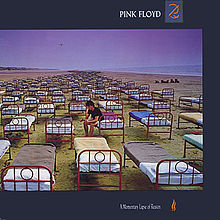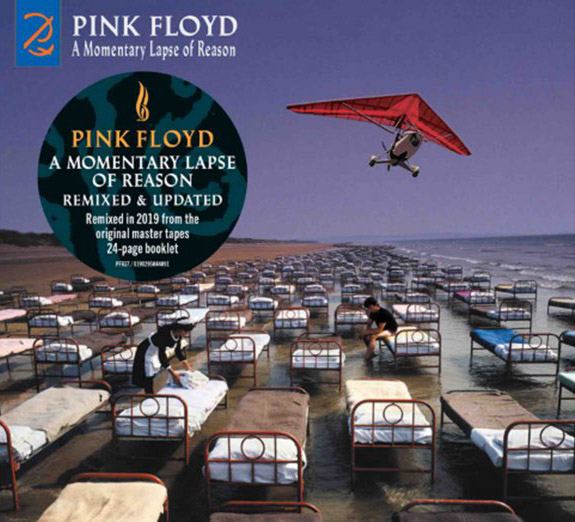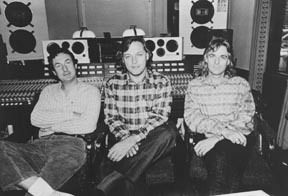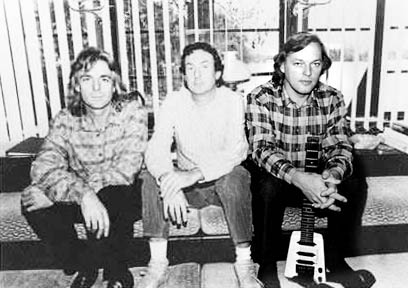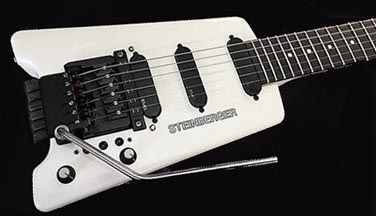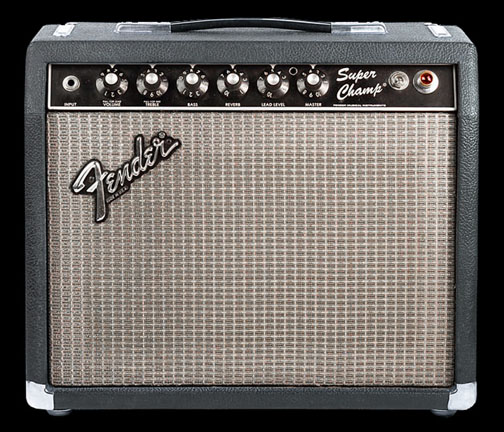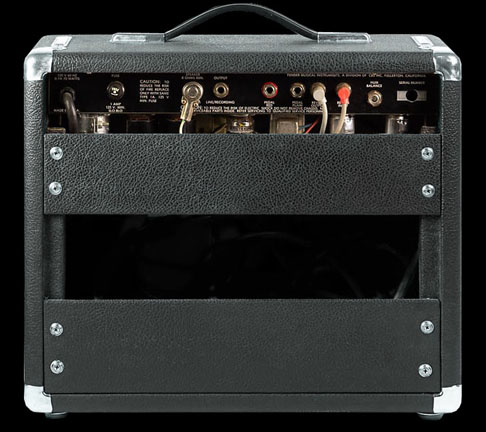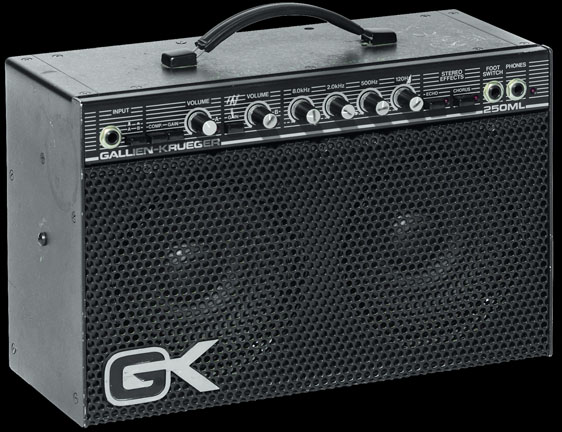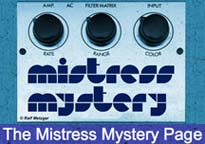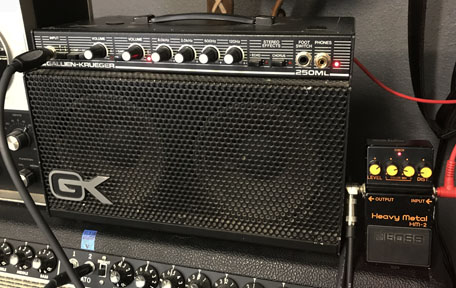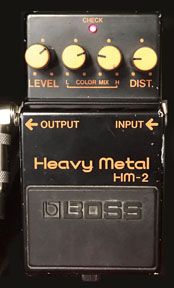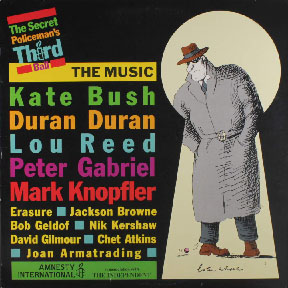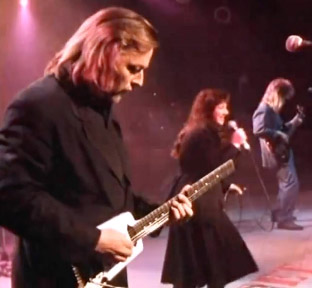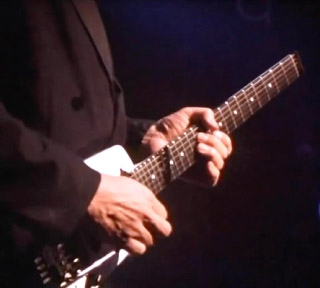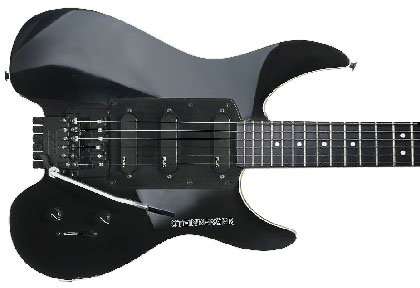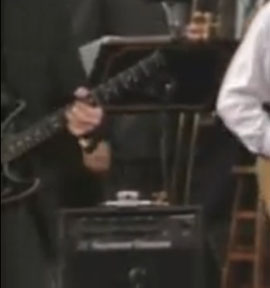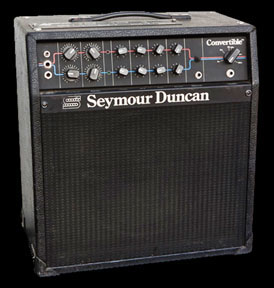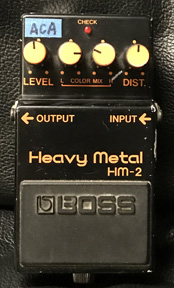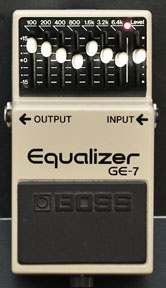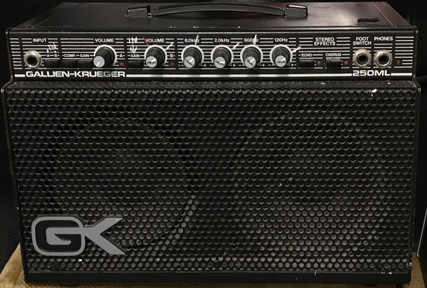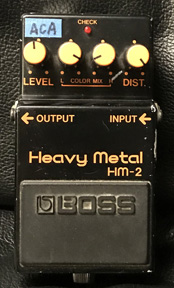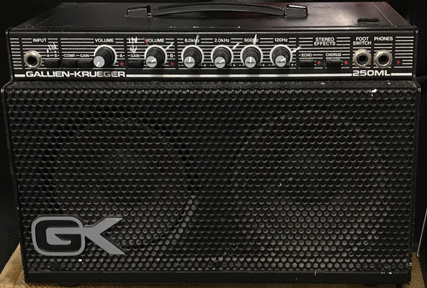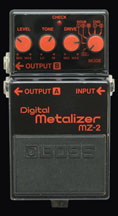NOTE: This website is frequently updated. Last update August 2022
For my setups and sound clips CLICK HERE
A Momentary Lapse of Reason 1987 cover art and the cover art for the 2019 remix
1986-87 - THE MOMENTARY LAPSE OF REASON LEAD TONES - This first Gilmour-led Pink Floyd album, released in 1987, spawned several radio hits like Learning to Fly, On the Turning Away, and Sorrow. It featured very little playing from Floyd members Nick Mason and Rick Wright, but it was still very successful in relaunching Pink Floyd and featured some fantastic guitar work from Gilmour.
AMLOR is one of the few Floyd albums that sounds very dated to the period. The 1980s sound is all over it, especially the gated drum sounds. In December 2019 it was remixed and released as part of the Later Years box set, with a stand alone release following in 2021. David Gilmour and Andy Jackson updated and remixed the whole album, removing some of the gated 1980s drum sounds and replacing them with newly recorded drum tracks from Nick Mason. Rick Wright keyboards, taken from the 1987-88 tour recordings, were also mixed into some of the songs to "restore the creative balance between the three Pink Floyd members". Other than the On the Turning Away solo, most of David's guitar tones sound better in the remix.
There is very little information about the original AMLOR recording sessions, but some facts are known. Most of the demos and studio recordings were done in the cramped recording rooms of the Astoria, David's floating recording studio anchored on the River Thames. Bob Ezrin, who produced Pink Floyd's The Wall and David's About Face album, was the producer. Recording and mixing stretched from November 1986 - March 1987.
![]() David Gilmour solos from the Berlin song Pink And Velvet
David Gilmour solos from the Berlin song Pink And Velvet
David's high gain lead guitar tone sounded like a continuation of the tone he used on the Berlin song Pink & Velvet. That was recorded in 1986 for Berlin's Count Three & Pray album sessions, which Bob Ezrin also produced. For the AMLOR sessions David used two small Fender Super Champ combos in stereo and a Gallien Krueger 250ML combo amplifier. Among the effects David used were a Boss HM-2 Heavy Metal pedal, an Electro-Harmonix Big Muff, a Boss GE-7 graphic equalizer, a Boss CE-2 chorus pedal, a stereo Ernie Ball volume pedal, two Boss DD-2 Digital Delay pedals, and an MXR Digital Delay System II rack unit. For electric guitars, David used his 57V red Strat and a Steinberger GL3T, each equipped with EMG-SA pickups and the SPC EQ.
Below are extractions of David's lead guitars, for tone and learning reference.
Although we do not know which guitars were used for each song, David has said the Steinberger was used prominently on the album, particularly for the Sorrow intro and the solos. It is also confirmed that David used the red Strat on the songs Signs of Life and Learning to Fly. David said in the October 1988 issue of Guitar magazine that the guitar solos for On the Turning Away and Sorrow were the first takes for each song. He stayed on board the Astoria for one weekend in late 1986 and wrote the Sorrow lyrics, the music, and played and recorded all the instruments himself. The Sorrow solo was recorded the day the song was written.
In February 1987 the recording sessions moved to Los Angeles and the Sorrow intro was replayed through the PA system of the LA Memorial Sports Arena and rerecorded with multiple mics to get the huge arena sound.
Promotional photos of David Gilmour, Nick mason, and Rick Wright during mixing sessions for A Momentary Lapse of Reason, and the white Steinberger GL3T with TransTrem used on much of the record
Looking at the rigs we know David used just prior to and just after AMLOR, we can get an idea about some of the setups used for the album. He was still using some of his pre 1986 gear - a Big Muff, a Boss HM-2, Boss GE-7 equalizers, a Boss compressor, along with chorus and delay. The primary setup for most of the tracks seems to be a split signal with one feed going to a Boss HM-2 running into a Fender Super Champ amp set for a clean tone and the other feed going into the gain channel of a Gallien Krueger 250ML. Another setup seems to be the Boss HM-2 going into the 250ML(used in the signal chain as an overdrive effect) then into a Super Champ. Note the GK amp was used as an overdrive and EQ in the signal chain, not powering a speaker cabinet. That was a similar setup as David's 1984-86 rigs, but in that rig he used a Mesa Boogie in place of the GK amp.
1982 Fender Super Champ 18w amp
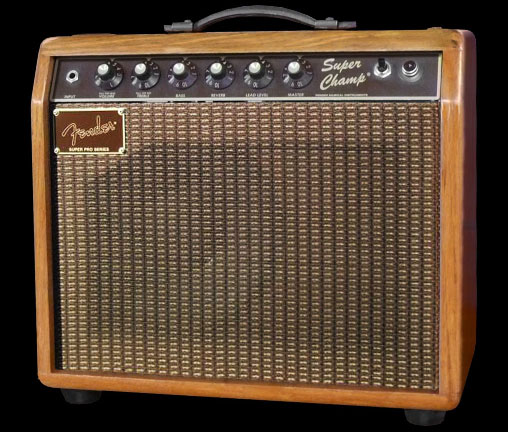
1982-85 Fender Super Champ Deluxe. David used this version in a March 1987 performance with Kate Bush
FENDER SUPER CHAMP - The Super Champ was a small combo amp from Fender's Paul Rivera design era, sold from 1982-1986. Rivera managed the revamped 1982 Fender design team responsible for all the Series II amps, including the Super Champ. It was based on one of the first amps Rivera ever built as a young boy, a hot-rodded Princeton Reverb with a master volume, but without the reverb. That concept was developed into the '82 Super Champ by Ed Jahns and Rivera, and was one of the last point-to-point wired Fender amps built. It was powered by two 6V6GT tubes running 18w into a 1x10" speaker.
Designed to compete with Mesa/Boogie 2-channel amps that were very popular at the time, the Super Champ also featured a 2-channel design with a foot-switchable lead channel gain stage for an overdrive sound, master volume, reverb, and a mid boost pot. It was very versatile and covered a wide range of tones. The blackface style clean channel sounded very similar to a Fender Princeton. The 50w 10" Eminence speaker it shipped with had a lot of mid range and not much bottom end. Many consider these to be the best sounding of all the Rivera era Fender amps. These have become collectors items now, but the 6C10 compactron preamp tube it uses are no longer produced, expensive, and hard to find.
Although the Super Champ had lots of bells and whistles, David used it strictly for its Princeton-like blackface Fender clean tone. The Treble pull pot that added a mid boost may have also been something that appealed to Gilmour. David ran his signal chain into two Super Champs, one for the left channel and one for the right, similar to how he used his Fender Concert and Twin Reverb II amps from 1984-86. I doubt that David used the spring reverb in the Super Champ at all. There is a lot of reverb in the On the Turning Away solo, but it sounds more like room reverb or studio plate reverb from the EMT plate reverbs in David's Astoria recording studio.
David Gilmour's Gallien Krueger 250ML amp with white tic marks showing some of his settings. It was auctioned for charity in 2019.
GALLIEN KRUEGER 250ML - The 250ML was a small, lunchbox-sized solid state stereo amp with built in effects, first marketed in 1983. David Gilmour first used one in his 1986 stage rig as well as in recording studios in 1987 and 1988. It was a tiny amp that looked like a 1980s boombox with two built in 4” speakers. Many people used it for a practice amp, but it was actually a 100w gigging amp head that could power two 4x12 speaker cabinets in stereo. It sounded a little similar to a Rockman headphone amp of the time, but the 250ML had a full power amp inside and full EQ controls, as well as built in compression, chorus, and delay. It was used by numerous hair metal bands at the time like Iron Maiden, but guitarists like Alex Lifeson of Rush and Richie Sambora of Bon Jovi also used them. The clean channel with chorus is very much a 1980s sound. Many people found the sound too sterile and processed sounding for blues-based style rock and roll, but it could be set for a bluesy overdrive sound. It was definitely a change from David's familiar Big Muff and Boss pedal tones from the previous years.
250ML had switchable clean (A) and distortion (B) channels. The clean channel included a button-switchable gain boost and compression, for a light overdrive sound. The distortion channel also included a gain boost button and the level of distortion gain increased with the volume. There was also a switchable chorus and echo effect that worked with both channels. There were two ways to run the 250ML in a pedal board signal chain like David used it. One way was to send a line from the pedal board to the 250ML front Input, then return to the pedal board using the effects loop Send jack on the back. This bypassed the chorus and echo effects however. Another way was to use the XLR Direct output on the back, which retained the built in effects. Unfortunately there was no way to switch off the built in speakers when using the Direct output on the original version of the 250ML that David owned. GK added a switch to turn the speakers off in the Series II version. A dummy plug can also be inserted into the headphone jack to bypass the built in speakers when using the effect loop Send.
STEINBERGER GL3T - Steinberger headless guitars were very popular in the 1980s, used by musicians like Mark Knoppfler of Dire Strats, Lou Reed, Eddie Van Halen, and briefly by David Gilmour. Ned Steinberger designed this series of bass and electric guitars in the late 1970s that featured a revolutionary minimalist design. He eliminated the large body, headstock, and moved all the tuning hardware to the tail of the guitar body. The small body and neck were completely synthetic, made of a practically indestructible carbon fiber/graphite mix. Steinberger could not keep up with the high production demand and sold the company to Gibson in 1987, but they quickly went out of favor with guitarists and production stopped in 1990. They are now collectors items and in the 2000s Steinberger guitars returned to production with the Synapse and Spirit lines. Although those guitars had similar headless look and body styles, they retained little of the materials and specs of the original Steinbergers.
The GL3T model was introduced by Steinberger in 1986 and David first tried one in October '86. He then had Steinberger custom make him one in 1987. The 3GLT was a three pickup version of Steinberger's GL model. David's was fitted with EMG-SA pickups like David's 57V Red Strat, which was also used to record the album. The 9v battery that powered the EMGs was stored in a compartment on the back of the guitar. It was later modifed to add a recessed toggle switch that activated the EMG SPC tone control.
Steinbergers were fitted with a TransTrem tremolo system that not only stayed in tune but allowed all six strings to stay in tune when changing pitch with the tremolo. This made it possible to play chords and have them stay in perfect tune when bending the the tremolo bar up or down. David used this to good effect with the intro to the song Sorrow, as well as the tremolo work on many of the guitar solos on the album. I remember first hearing Sorrow on the radio and being blown away by the intro sound.
Gilmour's Steinberger GL3T with TransTrem, EMG-SA pickups, and SPC tone circuit. It was sold at auction in 2019.
DAVID'S STUDIO SETUP - Determining the exact setups David actually used to create the album tones can be a bit tricky, since David, his Backline tech Phil Taylor, engineer Andy Jackson, author/researcher Richard Mahon, and author David Mead all seem to give contradictory info. Both David and producer Bob Ezrin have stated that David used a Gallien Krueger 250ML amp and Fender amps for most of the tracks recorded on the Astoria, but there are a lot of confusing details that cloud the exact setup, pedals used, and signal chain.
"...so we couldn't keep the (big) amps in the same room with us, and we were forced to use slightly smaller amplifiers. But after playing around with them in the demo stages of the project, we found that we really like the sound. So a Fender Princeton and a little G&K amp became the backbone of Dave's guitar sound for that record." - Bob Ezrin from Guitar World February 1993
No one else mentioned a Princeton in the studio, just the Super Champ, so I think Ezrin is mistaken there or just thought it was a Princeton, as the Super Champ had a similar Blackface Princeton sound. The one song we have specific (but contradictory) studio gear info about is Sorrow, so I use that as the basis of the album setups, and my ears. Author Richard Mahon detailed the rig on his Spare Bricks website, with info from engineer Andy Jackson. He refers to the Sorrow intro here, but Jackson also said this was the main setup for the whole album:
"The guitar signal was split by a stereo volume pedal into two delay pedals. The volume pedal also ran between the pre-amp and power amp of the first feed--into a Gallien-Krueger 250ML amplifier. The second feed was sent to a Boss HM-2 Heavy Metal pedal into a Boss GE-7 graphic equalizer then into a Fender Super Champ amplifier. The main guitar track of "Sorrow" was recorded this way. This was the basic setup for most of the album. The (Sorrow) intro was a Steinberger plugged into a Big Muff then a Fender Concert amp. Gilmour took the tapes and ran the intro through a loudspeaker setup at the Los Angeles Sports Arena."
Jackson's signal chain description is probably unintentionally confusing and out of order, as the delays would not be first in line, but that may have been how the pedals were laid out when he saw them on the studio floor. Author David Mead (Guitar Techniques magazine) claims David used a Steinberger through a Big Muff for Sorrow, along with a Boss GE-7 equalizer, and an Ernie Ball volume pedal. No mention of the Gallien Krueger or HM-2. He also says it was originally played through a Fender Concert 1x12, not a Super Champ, then that recording was replayed through the Los Angeles Sports Arena PA system and re-recorded using a holophonic recording system
Phil Taylor, David's backline tech, claims the amps were Fender Super Champs, not a Fender Concert, but like David Mead he thinks the Big Muff was used for both the Sorrow solo and intro. David often used a two-amp stereo setup, which is why Phil referred to the amps in plural:
"David recorded the guitar parts and solo from Sorrow from A Momentary lapse of Reason on it (Steinberger with EMG-SA's), playing through a Big Muff distortion pedal, MXR delay, Gallien Krueger ML250, and Fender Super Champ amplifiers."
David himself actually stated the setup in 1988, just a year after recording it, so I assume it was still fresh in his memory. He is only talking about the Sorrow intro here:
"That very nasty distortion you hear at the beginning of the song is basically the result of the Steinberger going through two little amps in the studio - a Fender Super Champ and a Gallien-Krueger. I use a Boss Heavy Metal distortion pedal (HM-2) and a Boss digital delay pedal (Boss DD-2), which then goes into the Fender Super Champ. And that in combination with the internal distortion on the Gallien-Krueger was how I got that particular sound."
Note that David said "internal distortion" of the Gallien-Krueger, meaning the B distortion channel with the gain switched engaged. It could have been recorded using the built in speakers or recorded direct. In the October 1988 issue of Guitar magazine David described the setup for the Sorrow guitar solos. He does not mention the Boss HM-2, but he clearly used it because the disortion channel of the 250ML alone does not sound like the album solo tone.
"The solo was done first take with a Steinburger through a little Gallien-Krueger and a Fender Super Champ. I never got around to doing it again."
So Richard Mahon, David Mead, and Phil Taylor all say the Sorrow intro was a Big Muff and multi amp combo, but David says it was an HM-2 and multi amp combo. Phil says David uses an MXR delay, but David says it was a Boss DD-2. All we can get from that is that probably all of that gear was used in the sessions at some point, and there were different setups used for different songs that may have gotten confused or misremembered. David, Phil , and Andy all say the Fender amps used were Super Champs, not a Princeton or Concert, so I think at least that part is correct.
David was also doing a lot of session work in 1987 and 1988 for other musicians (Dalbello, Bryan Ferry, Sam Brown, Peter Cetera, Liona Boyd, John "Rabbit" Bundrick), in addition to touring with Pink Floyd. Phil Taylor again talked about David's studio setup in a 1988 issue of Guitar World, referring to his recent session work. No mention of the Boss HM-2 this time, and Phil implies the 250ML was used as an overdrive directly into the Super Champ.
"In the studio, David likes to tinker around and get his sound as quickly and as easily as possible. He plugs into a Boss CS-2 compressor, a T.C. 2290 for delay and a Yamaha SPX90 for stereo chorus. Then it's into a Gallien-Krueger 250ML amplifier at an overdriven setting into a Fender Super (Fender Super Champ) tube amp at a clean setting." "A lot of the time," Taylor explains, "David will be right in the control room with the amp right there on the floor as he plays. I guess he likes that immediacy of the sound. It's a good way of knowing where you're at!" - Phil Taylor from Guitar World magazine 1988
Gallien Krueger 250ML Series II and Boss HM-2
I happen to think a two-amp setup of the Boss HM-2 into the Super Champ blended with Gallien Krueger 250ML distortion channel was used for most of the lead solos on AMLOR, including the On the Turning Away solo, as that is what it sounds like to my ears. This is simply another one of David's blended, multi-amp setups. Very small amps in this case. If you listen to some of the solos on David's 1984 About Face album, such as Let's Get Metaphysical, and compare it to the OTTA solo, you will hear a similar tone. If you listen to the Berlin song Pink & Velvet recorded in 1986 and compare it to the Sorrow solos, you will hear a silimar tone.
So how did David use the 250ML and HM-2 together? Those various quotes above say David used the built in distortion or the overdrive of the 250ML along with the Boss HM-2, going to two separate Fender amps, but nothing clearly indicating whether the 250ML and HM-2 were split to separate signal chains to each amp, or both in the same signal chain, with the split to amps after. Here are three possible setups:
Setup #1) Stereo Volume Pedal split to two channels:
Channel 1 > Boss CS-2 > (Boss HM-2 or Big Muff) > Boss GE-7 (bass boost, mids cut ) > Boss DD-2 > Chorus > Fender Super Champ set for a clean tone.
Signal split using the direct out from the DD-2 to the second Fender Super Champ set for a clean tone
Channel 2 > Gallien Krueger 250ML using B channel and gain switch engaged. Recorded using the built in speakersSetup #2) Boss CS-2 > Distortion (Boss HM-2 or Big Muff) > Boss GE-7 (bass boost, mids cut ) > Stereo Volume Pedal split to two channels:
Channel 1 > Boss DD-2 > Chorus > Fender Super Champ set for a clean tone.
Channel 2 > Gallien Krueger 250ML set for overdrive (using the Direct Out or Send) > Boss DD-2 > Fender Super Champ set for a clean tone
Setup #3) Boss CS-2 > Distortion (Boss HM-2 or Big Muff) > Boss GE-7 (bass boost, mids cut ) > Gallien Krueger 250ML set for overdrive (using the Direct Out or Send) Stereo Volume Pedal split to two channels:
Channel 1 > Digital Delay > Chorus > Fender Super Champ set for a clean tone.
Channel 2 > Digital Delay > Fender Super Champ set for a clean tone
I tested all three ways using a clean tone from a 65 Twin Reverb and a 59 Bassman amp in place of the Super Champ. I think most of the songs used setup #1, a two-channel setup with the HM-2 going to the Super Champ in one channel and the 250ML in the other, so they do not interact. I also think there are some parts with only the HM-2 and Super Champ, other parts with the 250ML into a Super Champ, and others with only the 250ML.
Photos of David's 250ML have tic marks indicating his EQ settings and that he used the B channel with the gain switch engaged. I tried various settings running the HM-2 into the 250ML using the B channel with gain switch engaged. I then tested using the HM-2 with the 250ML clean channel, with and without the gain boost engaged. It is very difficult to get anything that sounds like the album lead guitar tones with the HM-2 into the 250ML.
Depending on the 250ML EQ settings, either having the gain boost engaged or off can be made to sound like the lead tones using either the clean or distortion channels. Using the 250ML alone (no HM-2) with gain boost off, seems to be the clean tone heard on most of the record, including Signs of Life. I tested both using the built in 250ML chorus and using a Boss CE-2 chorus. I think David used the built in chorus when playing clean tones, and the CE-2 with when he used the HM-2 and 250ML.
BEST SUBSTITUTE FOR THE G-K 250ML/HM-2 COMBO? - The Boss MZ-2 Digital Metalizer is very close to this sound, and David actually started using one himself in 1988 during the Momentary Lapse of Reason tour for overdrive. The MZ-2 blends very well with overdrives and distortions like the TC-BLD, Boss Blues Driver, BK Butler Tube Driver, and Big Muff. It is a Gilmour-in-a-box pedal and is perfect for the lead tone heard in On the Turning Away when played through a mid scooped Fender amp like the Twin Reverb. Boss released it in late 1987 as a replacement for the HM-2, although it did not really sound anything like the HM-2. It is voiced similarly to the Gallien-Kreuger with Gilmour's EQ settings, and even includes a built in chorus like the G-K, so this may have been an attempt by Boss at appealing to the G-K users.
David performing with Kate Bush in March 1987
RUNNING UP THAT HILL WITH KATE BUSH IN 1987 - At the end of the MLOR recording sessions in March David peformed at a benefit with Kate Bush, The Secret Policeman’s Third Ball, a charity event for Amnesty International at the London Palladium. The Policeman's Ball shows shows took place over four consecutive nights on March 26–29 and were recorded on video. Two television specials and home video from Virgin Visions were edited together from the performances, including this performance of Bush's song Running Up That Hill. David, who was instrumental in getting Kate Bush's professional music career off the ground, played guitar on several of her songs, including Rocket's Tail and Love and Anger. He did not play on the original studio version of this song.
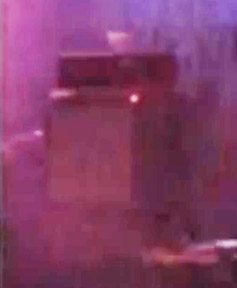
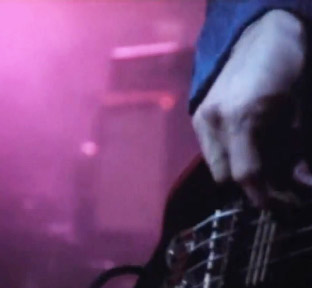
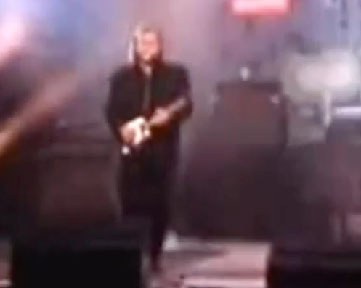
David's Fender Super Champ Deluxe combo can be seen in the background with a rack effect on top, possibly his MXR Digital Delay
David stopped using the large rig he had been using from 1984-86. Instead, he began using the first of several smaller, simplaer rigs. For this performance he used a similar rig as he used for the MLOR sessions, although his synth-like guitar tone and playing were very unique here. Most of the parts he played were originally performed on a keyboard for the studio version.
Running Up That Hill - live 1987 excerpt
David used his Steinberger GL3T guitar, with heavy use of the Trans Trem. The amp he used appeared to be a Fender Super Champ Deluxe combo. This Deluxe version was the same as the amp as the standard version, but housed in a mahogany cabinet with a blackface control plate. It's look was remeniscent of the old Fender tweed amps.
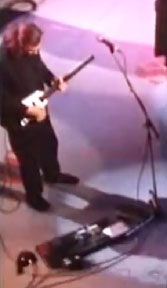
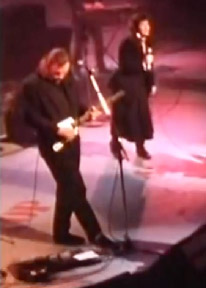
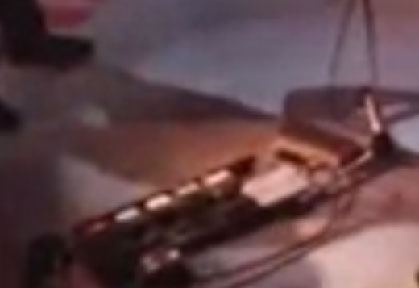
David used a small pedal board and a volume pedal. I could not make out the individual pedals, but based on the sound he probably used some of the same pedals he was using priot to this - a Boss CS-3 compressor, Boss HM-2 Heavy Metal, and Boss CE-3 chorus. There was a rack effect on top of the Super Champ, possibly David's MXR Digital Delay System, but he may have also used a Boss DD-2 digital delay. I get very close to this tone using that exact setup into a digital delay set for 110ms, delay volume at maximum, with 3 repeats. I dial the depth of the chorus to around 3:00 for a flange-like sound.
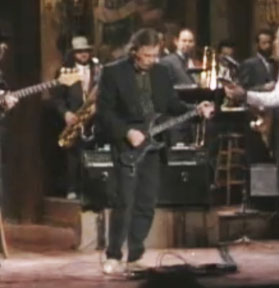
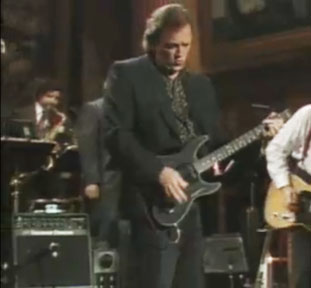
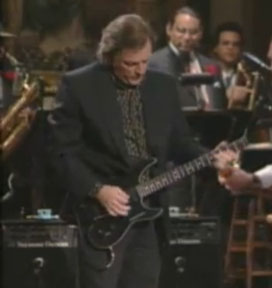
David playing his Steinberger GM 3T through a pair of Seymour Duncan Convertible 100 amps
SATURDAY NIGHT LIVE PERFORMANCE IN 1987 - The first leg of Pink Floyd's North American Momentary Lapse of Reason tour came to an end on December 10th, 1987. Since he was still in America, David made a guest appearance with the Saturday Night Live band in New York, televised on December 12. David played lead on an instrmental, Song For My Sara, and with the band during the commecial breaks.
He used the next evolution of his new smaller-sized rig, which included a pair of Seymour Duncan Convertible 100 amps with an Alembic F2-B preamp and Hiwat SA212 combo stacked on top. This was stereo rig with what appeared to be a Boss CE-2 on top of one amp (for one channel) and a Boss DD-2 on top of the other amp (for the other channel). His small pedalboard looked similar to the one he used for the Kate Bush performance in March 1987, but I could not make out any of the pedals on it.
The Convertible 100 amp was a two-channel amp and the first amp to feature power scaling, allowing it to go from 1 watt to 100. It also featured different preamp modules that could be inserted into the five module slots, which was cutting edge technology for the time. It allowed the user to customize different preamp and gain stages, so you could make it sound like any amp you wanted, in theory.
Gilmour's Steinberger GM 3T and Seymour Duncan Convertible 100 amp
David played a brand new GM 3T guitar, Steinberger's first full-bodied design from their M-Series. This GM 3T model was custom-made for David and included EMG SA pickups, SPC presence control, and the Transposing Tremolo system. It was very similar to David's first GL 3T Steinberger, but with a body that looked more like a regular electric guitar. It was much cooler looking too, in my opinion. He used it again for two charity performances in 1989, the Smoke on the Water charity single for Rock Aid Armenia and performing My Girl with Jools Holland and Lenny Henry for the AIDS benefit, Hysteria II. It does not seem to have been used again in public it after that.
In my opinion David's SNL performance was one of the worst guitar tones I have ever heard from him. The tone was so compressed and nasal/trebly sounding that very little of David's unique style of playing and expression came through. I remember being very disappointed when I watched this live. David used a similar rig for his sessions with Paul Young for the song Heaven Can Wait in 1990, and for his guest appearances in John Martyn's band for his Apprentice tour in 1990.
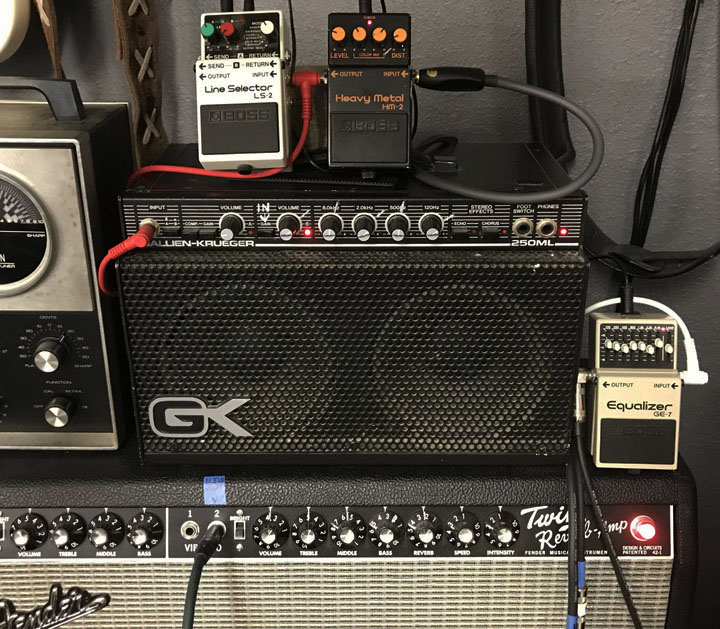
GETTING THE TONES - David's clean tones are a compressor, likely a Boss CS-2, into the clean channel on the 250ML. That was probably blended with his clean Fender amp tone. Most clean Fender amps, or even the Hiwatt, work for that sound with a compressor.
His bluesy overdrive tone from the Dogs of War solo sounds identical to the 250ML overdrive sound from channel B, with the built in slapback delay engaged, and a Boss CS-2 in line before the 250ML. When playing this live in 1987-88, David used the TC Electronic BLD (Booster + Line Driver & Distortion) for the overdrive, blended with the overdrive from a Mesa/Boogie Mark III amp head with a dummy speaker load. The TC BLD alone replicates this sound well, but many overdrives can produce a similar sound through a clean amp, including the BK Butler Tube Driver.
For the high gain lead tones, I have tried various signal chain setups using various amp settings, HM-2 settings, and GE-7 equalizer settings, but I have never successfully replicated all of those sounds. Photos of David's 250ML taken when it was auctioned in 2019 have knob markings indicating his exact settings, but there are no photos showing his HM-2 or amp settings.
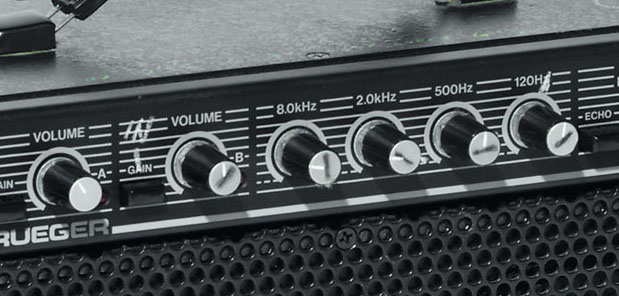
David's 250ML show tick marks that indicate David's settings and that he used the gain from channel B
My favorite tone on the album is the solo from On the Turning Away and I have struggled finding that exact tone for years. It's one of the few Gilmour solos that is awash in heavy reverb, which is a big part of the tone. I do not think David used the built in reverb of the Super Champ, and it sounds too big to be room reverb from the small recording rooms on the Astoria. It was likely the EMT plate reverb housed on the Astoria, added to the mix in post. To simulate it, I use a tiny amount of Fender spring reverb and plate reverb from a Free The Tone Ambi Space pedal.
My Boss HM-2, GE-7, and 250ML settings for the On the Turning Away solo
Below is the closest I have gotten to OTTA the studio recording using a Strat with EMG-SA bridge pickup and SPC boost, with the signal split into a two-amp setup. One signal goes to the HM-2 into a Fender 59 Bassman and the other signal goes to the 250ML using the internal disortion. I mic'd the speakers of the 250ML and the Bassman. The mix is about 60% Bassman and 40% 250ML. The Boss HM-2/Bassman is the core sound, but the 250ML amp is a critical part of the mix. It's a horrible, nasal sound, but when blended with the Fender, it completes the tone.
![]() On the Turning Away solo - Signal split into two channels with a stereo volume pedal.
On the Turning Away solo - Signal split into two channels with a stereo volume pedal.
Channel 1 - Boss CS-2 compressor > Boss HM-2 > Boss GE-7 > FTT Future Factory 540ms delay > FTT Ambi Space plate reverb > Fender 59 Bassman
Channel 2 - Gallien Krueger 250ML, B channel with gain switch and built in chorus engaged. Boss DD-2 430ms delay in send/return.
![]() On the Turning Away Solo Tone Build - in this order
On the Turning Away Solo Tone Build - in this order
1. Gallien Kerueger 250ML
2. HM-2 + GE-7 into 59 Bassman
3. Both amps mixed together
4. Plate Reverb Added from FTT Ambi Space
Below is a take using just using the Gallien Krueger amp clean channel.
![]() On the Turning Away solo - TC BLD (Booster+Line Driver & Distortion) > Boss HM-2 > Boss GE-7 > Boss CE2B chorus (50% mix) > Future Factory delay > Gallien Krueger 250ML clean channel
On the Turning Away solo - TC BLD (Booster+Line Driver & Distortion) > Boss HM-2 > Boss GE-7 > Boss CE2B chorus (50% mix) > Future Factory delay > Gallien Krueger 250ML clean channel
________________________________________________
Below is one of my early attempts at the studio version of this solo tone using only the HM-2 for distortion, but I think it is a poor replication of that tone.
![]() On the Turning Away solo - Strat with EMG-SA pickups (SPC control on 4-5), Boss CS-2 compressor, Boss HM-2 Heavy Metal, Big Muff, Boss GE-7 equalizer (set for mids boost), TC Nova delay, Boss CE-2 chorus, into a clean Fender Twin Reverb.
On the Turning Away solo - Strat with EMG-SA pickups (SPC control on 4-5), Boss CS-2 compressor, Boss HM-2 Heavy Metal, Big Muff, Boss GE-7 equalizer (set for mids boost), TC Nova delay, Boss CE-2 chorus, into a clean Fender Twin Reverb.
Below is a test using the 250ML distortion only, no Boss HM-2. The sound is similar, but still not very accurate, and a bit too nasal sounding to my ears.
![]() On the Turning Away solo - Strat with EMG pickups > Boss CS-2 Compressor > Gallien Krueger 250ML channel B with gain boost engaged > Boss GE-7 > Boss CE-2B chorus set at 50% mix > Future Factory 580ms delay > Ambi Space reverb > 65 Fender Twin Reverb
On the Turning Away solo - Strat with EMG pickups > Boss CS-2 Compressor > Gallien Krueger 250ML channel B with gain boost engaged > Boss GE-7 > Boss CE-2B chorus set at 50% mix > Future Factory 580ms delay > Ambi Space reverb > 65 Fender Twin Reverb
Below is a test using the Boss HM-2 into the 250ML clean channel. The sound is closer, but still missing something.
![]() On the Turning Away solo - Strat with EMG pickups > TC Electronics BLD > Boss HM-2 > Boss CE-2B chorus set at 50% mix > Future Factory 540ms delay > Gallien Krueger 250ML channel A with gain boost off
On the Turning Away solo - Strat with EMG pickups > TC Electronics BLD > Boss HM-2 > Boss CE-2B chorus set at 50% mix > Future Factory 540ms delay > Gallien Krueger 250ML channel A with gain boost off
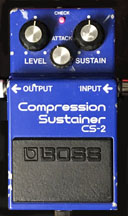

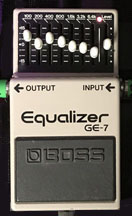
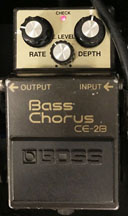
Boss pedal setings and Gallien Kreuger 250ML settings shown in green

65 Twin Reverb settings
Below is my high gain signal chain for the OTTA and Sorrow solos, using the Gallien-Kreuger 250ML, a Strat with EMG-SA pickups, and a Fender Twin Reverb amplifier. I send a line after the Boss HM-2 to the 250ML input, then use the XLR Direct output to send the signal back the the pedal board with an XLR-to-1/4" cable.
Boss CS-2 compressor > Distortion (Boss HM-2 or Big Muff) > Boss GE-7 > Gallien Krueger 250ML clean channel, gain boost engaged > Boss CE-2 chorus > TC Nova delay > Fender Twin Reverb
Below is the signal chain for the clean tones, like the Signs of Life solo.
Boss CS-2 compressor > Gallien Krueger 250ML clean channel, gain boost on, built in chorus on > TC Nova delay > Fender Twin Reverb
Other detailed setups and sound clips for the On the Turning Away solo can be found on this page.
_______________________________________________________________________________________________
My Boss HM-2 and 250ML settings for the Sorrow intro
Below is the closest I have gotten to Sorrow solo tone from the studio recording using a Strat with EMG-SA bridge pickup and SPC boost, with the signal split into a two-amp setup. One signal going to the HM-2 into a Fender 59 Bassman and Twin Reverb and the other signal going to the 250ML using the internal disortion. I mic'd the speakers of the 250ML, Bassman, and Twin. The mix is about 50% Bassman/Twin and 50% 250ML.
![]() Sorrow First Solo - Signal split into two channels with a stereo volume pedal.
Sorrow First Solo - Signal split into two channels with a stereo volume pedal.
Channel 1 - Boss CS-2 compressor > Boss HM-2 > Boss GE-7 > Boss CE-2 chorus > FTT Future Factory 540ms delay > L channel to Fender 59 Bassman and R channel to Twin Reverb
Channel 2 - Gallien Krueger 250ML B channel with gain switch engaged. Boss DD-2 delay in send/return.
![]() Sorrow First Solo Tone Build - in this order
Sorrow First Solo Tone Build - in this order
1. HM-2 + GE-7 into 59 Bassman
2. Gallien Krueger 250ML
3. Both amps mixed together.
_____________________________________________________________________________________________
I have never been able to replicate the intro tone for the Sorrow studio recording sucessfully. I think this may be due to the way the guitar tone was altered when it was replayed through the LA Sports Arena PA system and rerecorded for the final album mix. There is a unique tone and bloom as the notes decay that is very difficult to capture.
Below is the closest I have gotten, by running an HM-2 into a Ram's Head Big Muff, with extreme EQ'ing from a Boss GE-7. This clip sounds less like the original album mix and more like the 2019 remix, which has a much wider stereo field, more echo delays, and an undertone of flange-like modulation.
![]() Sorrow Intro - Signal split into two channels with a stereo volume pedal.
Sorrow Intro - Signal split into two channels with a stereo volume pedal.
Channel 1 - Boss HM-2 > Rams Head Big Muff > Boss GE-7 > FTT Future Factory 640ms delay > L channel to Fender 59 Bassman and R channel to Deluxe Electric Mistress into a Twin Reverb
Channel 2 - Gallien Krueger 250ML B channel with gain switch engaged. Electric Mistress and Boss DD-2 delay in send/return.
Below are a few less successful attempts using different setups.
![]() Sorrow Intro - Boss CS-2 compressor > Big Muff > Boss GE-7 > Gallien Krueger 250ML clean channel, no gain boost > TC Nova delay > Fender Twin Reverb
Sorrow Intro - Boss CS-2 compressor > Big Muff > Boss GE-7 > Gallien Krueger 250ML clean channel, no gain boost > TC Nova delay > Fender Twin Reverb
![]() Sorrow Intro - Signal split into two channels with a stereo volume pedal.
Sorrow Intro - Signal split into two channels with a stereo volume pedal.
Channel 1 - Boss CS-2 compressor > Boss HM-2 > Boss GE-7 > FTT Future Factory 640ms delay > L channel to Fender 59 Bassman and R channel to Twin Reverb
Channel 2 - Gallien Krueger 250ML B channel with gain switch engaged. Boss DD-2 delay in send/return.
_____________________________________________________________________________________________
ALTERNATE MOMENTARY LAPSE OF REASON LEAD TONE SETUP - Another simple alternative to get the AMLOR high gain lead tone is the Boss MZ-2 Heavy Metal pedal. The settings shown above are similar to the On the Turning Away lead tone sound. For me, it sounds most accurate into a Fender Bassman, but it gets close to the AMLOR tones with other amps as well, including a Hiwatt.
![]() On the Turning Away solo using Boss MZ-2 - Boss CS-2 compressor > Boss MZ-2 > Boss CE-2B chorus > Future Factory delay > Fender 59 Bassman
On the Turning Away solo using Boss MZ-2 - Boss CS-2 compressor > Boss MZ-2 > Boss CE-2B chorus > Future Factory delay > Fender 59 Bassman
Kit’s Secret Guitar, Gear, and Music Page
Guitar stuff, gear stuff, soundclips, videos, Gilmour/Pink Floyd stuff, photos and other goodies.
Copyright Kit Rae.
VISIT MY SWORDS, KNIVES and FANTASY ART WEBSITE www.kitrae.net

